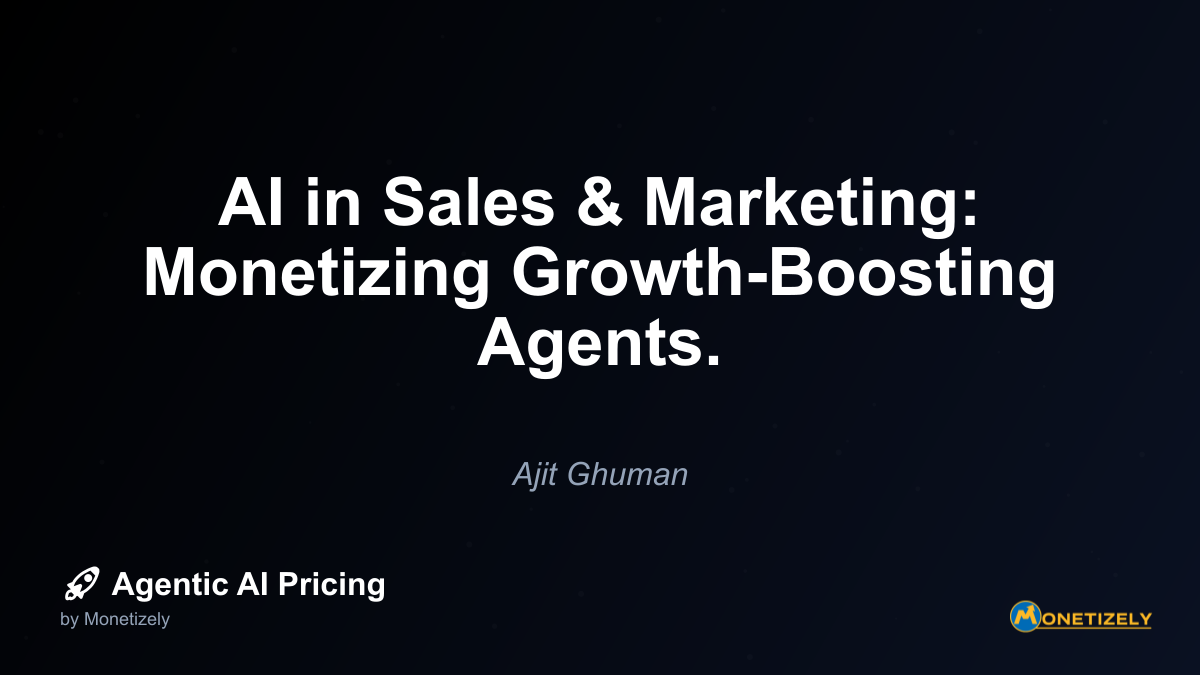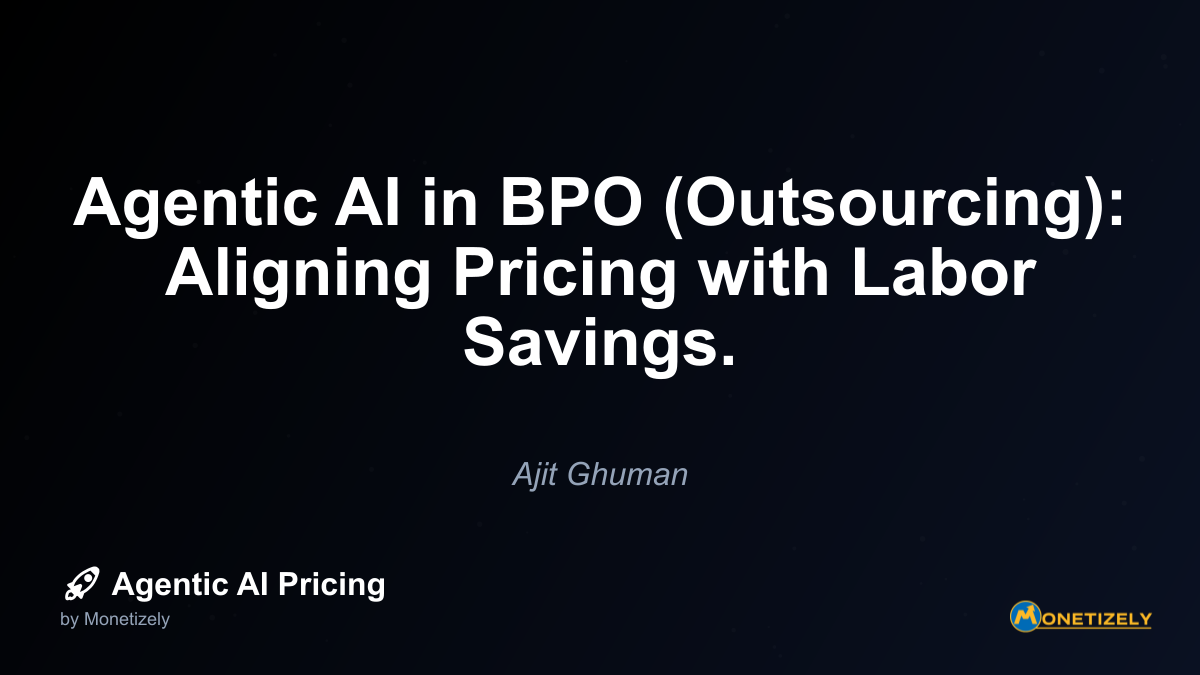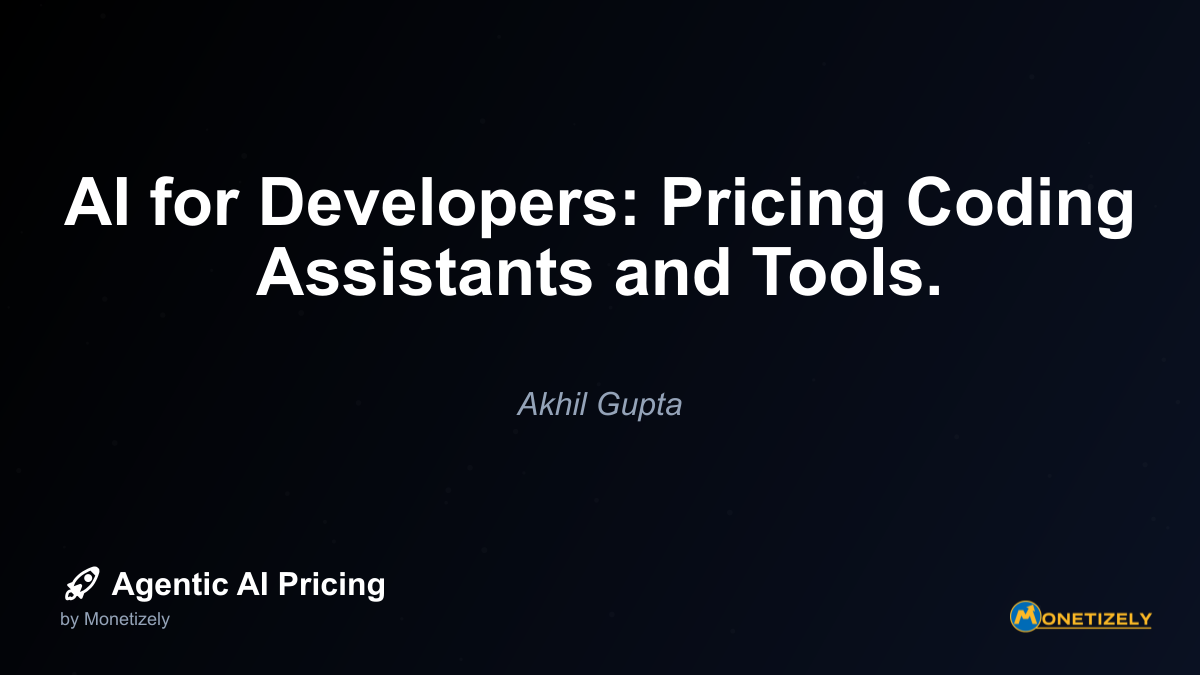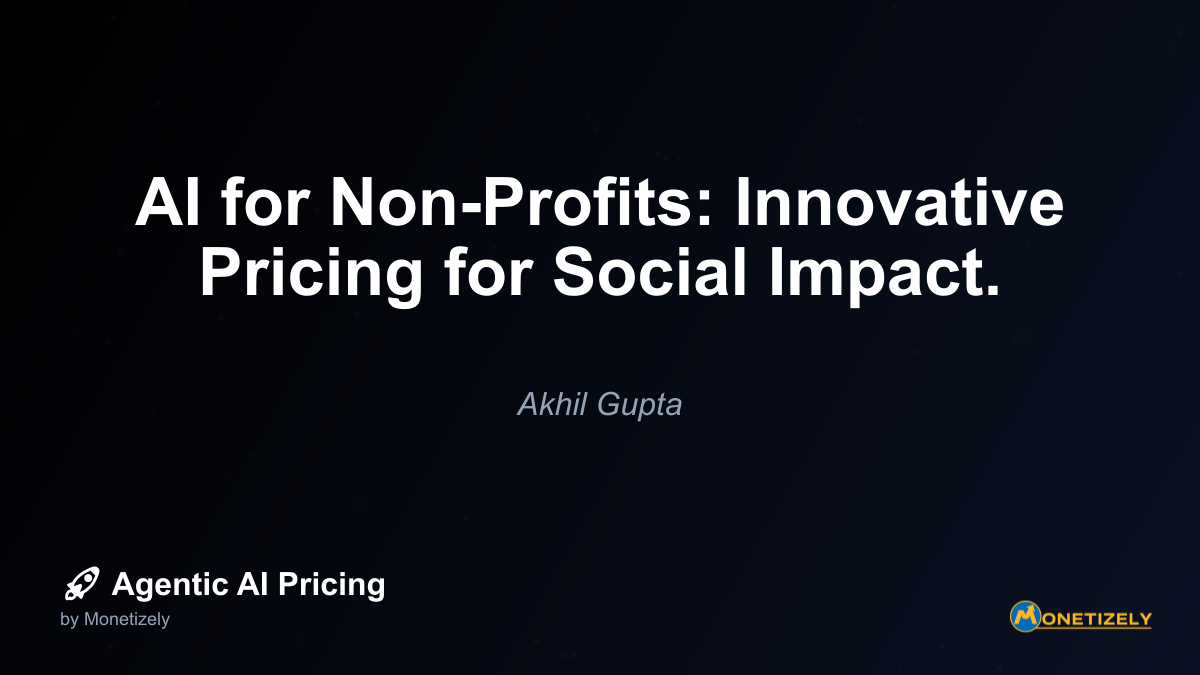· Ajit Ghuman · Industry Insights · 10 min read
AI in Sales & Marketing: Monetizing Growth-Boosting Agents.
AI and SaaS Pricing Masterclass
Learn the art of strategic pricing directly from industry experts. Our comprehensive course provides frameworks and methodologies for optimizing your pricing strategy in the evolving AI landscape. Earn a professional certification that can be imported directly to your LinkedIn profile.

AI has transformed how businesses approach sales and marketing, offering unprecedented capabilities to streamline operations, enhance customer interactions, and drive revenue growth. From AI-powered CRM assistants to sophisticated lead scoring algorithms and content generation tools, these technologies are reshaping the competitive landscape across industries.
The Evolution of AI in Sales and Marketing
The integration of artificial intelligence into sales and marketing functions represents a natural evolution of these disciplines. Traditional sales and marketing relied heavily on human intuition, manual processes, and limited data analysis. Today’s AI-augmented approach leverages vast datasets, machine learning, and automation to identify patterns, predict outcomes, and execute tasks with greater efficiency and precision.
This evolution has progressed through several distinct phases:
- Basic automation (2000s): Simple rule-based systems automated repetitive tasks
- Predictive analytics (2010s): Statistical models began forecasting customer behaviors and sales outcomes
- Conversational AI (late 2010s): Chatbots and virtual assistants enabled scalable customer interactions
- Agentic AI (2020s): Advanced AI systems that operate with greater autonomy, making decisions and taking actions with minimal human oversight
The most recent advancement toward agentic AI represents a significant leap forward. Unlike earlier systems that required extensive human management, modern AI sales and marketing agents can independently execute complex workflows, adapt to changing conditions, and deliver measurable business outcomes.
Key AI Agent Categories Transforming Sales and Marketing
AI-Enhanced CRM Assistants
CRM platforms have evolved from simple contact databases to sophisticated relationship management hubs powered by AI. These systems now incorporate intelligent assistants that transform how sales teams operate.
Capabilities include:
- Automated data entry and enrichment: Capturing customer interactions across channels and automatically updating records
- Action recommendations: Suggesting next best actions based on historical patterns and current context
- Pipeline management: Predicting deal progress and highlighting at-risk opportunities
- Conversation intelligence: Analyzing sales calls to extract insights and coaching opportunities
Pricing models:
Most major CRM platforms like Salesforce, HubSpot, and Microsoft Dynamics have integrated AI capabilities into tiered subscription models. These typically follow one of three approaches:
- AI as a premium tier: Advanced AI features available only in higher-priced enterprise plans
- AI as add-on modules: Core AI capabilities sold as supplementary packages
- Feature-specific pricing: Individual AI tools priced separately based on functionality
For example, Salesforce Einstein offers various AI components that can be purchased individually or as part of broader packages, with pricing ranging from $50 per user monthly for basic features to several hundred dollars for advanced capabilities.
Lead Scoring and Qualification Agents
Lead scoring has evolved dramatically with AI, moving beyond simple demographic and behavioral scoring to sophisticated predictive models that continuously improve.
Capabilities include:
- Predictive lead scoring: Assessing lead quality based on thousands of data points
- Buying intent detection: Identifying signals that indicate readiness to purchase
- Account prioritization: Focusing sales efforts on highest-potential accounts
- Churn prediction: Flagging at-risk customers for proactive retention efforts
Pricing models:
Lead intelligence platforms typically price their AI capabilities based on:
- Volume-based pricing: Costs scaled to number of leads processed
- Outcome-based pricing: Fees tied to successful conversions or revenue generated
- Subscription tiers: Feature access determined by monthly subscription level
MadKudu, for instance, offers predictive lead scoring with pricing based on the volume of leads processed monthly, while 6sense provides account-based intelligence with tiered pricing based on both features and data volume.
Content Generation and Optimization Agents
AI content tools have revolutionized marketing production capabilities, enabling personalization at scale and continuous optimization.
Capabilities include:
- Automated content creation: Generating blog posts, social media updates, and ad copy
- Personalization engines: Tailoring content to individual preferences and behaviors
- A/B testing automation: Continuously optimizing messaging for maximum impact
- SEO enhancement: Recommending content improvements for search visibility
Pricing models:
Content AI tools employ several monetization approaches:
- Usage-based pricing: Costs tied to content volume (words, images, videos generated)
- Seat-based licensing: Priced per user with varying access levels
- Output licensing: Rights to AI-generated content determined by subscription tier
- Performance-based upcharges: Premium fees for enhanced performance metrics
Jasper, a leading AI content platform, uses a tiered subscription model with pricing based on word volume and user seats, while tools like Phrasee employ performance-based pricing for AI-optimized email subject lines.
Pricing Strategies for AI Sales and Marketing Tools
The pricing of AI sales and marketing tools reflects their position on the value chain and the tangible outcomes they deliver. Several dominant pricing strategies have emerged:
Value-Based Pricing
The most sophisticated AI tools tie their pricing directly to the business value they create. This approach aligns vendor and customer incentives while commanding premium prices for high-performing solutions.
Implementation approaches:
- Revenue sharing: Vendor receives percentage of incremental revenue generated
- Performance fees: Pricing tied to specific KPI improvements
- Success tiers: Base subscription plus performance-based pricing tiers
For example, Drift’s conversational marketing platform offers pricing tiers based partly on the volume of pipeline generated through their AI chatbots, with enterprise customers paying for results rather than just functionality.
Tiered Subscription Models with AI Differentiation
Many established SaaS platforms use AI capabilities as key differentiators between pricing tiers, effectively using advanced AI as a premium feature set.
Common structures:
- Basic tier: Limited or no AI functionality
- Professional tier: Core AI capabilities for individual users
- Enterprise tier: Advanced AI with organization-wide benefits
HubSpot exemplifies this approach, with their Marketing Hub offering increasingly sophisticated AI capabilities at higher pricing tiers, from basic content suggestions in lower tiers to advanced predictive lead scoring and content optimization in enterprise packages.
Embedded vs. Add-On AI Pricing
A critical strategic decision for platform providers is whether to embed AI capabilities within core offerings or position them as premium add-ons.
Embedded AI pricing:
- Simplifies purchasing decisions
- Creates perceived value advantage over competitors
- May require raising base prices or accepting margin compression
Add-on AI pricing:
- Creates new revenue streams from existing customers
- Allows precise value capture from AI capabilities
- Enables more granular feature development and pricing
Salesforce has pursued both strategies simultaneously, embedding basic Einstein AI features in core products while offering advanced AI capabilities as premium add-ons with separate pricing.
Measuring AI Value to Support Pricing Decisions
For both vendors and customers, quantifying the value of AI sales and marketing tools is essential for pricing decisions. Several methodologies have emerged:
Sales Lift Attribution
The most direct measure of AI impact is incremental revenue generation. Advanced attribution models can isolate the specific contribution of AI tools to revenue outcomes.
Key metrics:
- Conversion rate improvements: Measured across funnel stages
- Average deal size increases: Value expansion in AI-assisted deals
- Sales cycle compression: Time-to-close reduction
- Competitive win rate changes: Market share gains
InsideSales (now XANT) demonstrated the value of their AI-powered sales engagement platform by documenting average pipeline increases of 30% for customers, directly supporting their premium pricing strategy.
Efficiency and Productivity Gains
For AI tools focused on operational improvements, productivity metrics provide compelling value evidence.
Key metrics:
- Time savings: Reduced hours spent on manual tasks
- Capacity expansion: Additional customers/prospects handled per rep
- Administrative reduction: Decreased non-selling time
- Ramp time improvement: Faster new hire productivity
Gong’s conversation intelligence platform justifies its premium pricing by demonstrating that sales reps using their AI spend 62% more time selling and 39% less time on administrative tasks.
Predictive Accuracy and Decision Quality
The accuracy of AI predictions directly correlates with business value, making this a critical measurement area.
Key metrics:
- Lead scoring precision: Correlation between scores and conversion rates
- Forecast accuracy: Variance between predicted and actual results
- Content performance prediction: Alignment of projected and actual engagement
- Churn prediction accuracy: Correct identification of at-risk accounts
6sense’s account-based platform demonstrates that their AI-identified in-market accounts convert at 5x higher rates than unscored accounts, providing clear ROI justification for their pricing.
Case Studies: Successful AI Monetization in Sales and Marketing
Drift: Conversational Marketing Platform
Drift pioneered conversational marketing with AI chatbots that engage website visitors and qualify leads in real-time.
Pricing approach:
- Tiered subscription model with chatbot capabilities as key differentiator
- Enterprise tier includes revenue-based pricing component
- Custom AI training available as premium service
Value metrics:
- 670% ROI documented in Forrester Total Economic Impact study
- 82% increase in qualified sales meetings
- 36% higher conversion rates from chat interactions
Drift’s success demonstrates how combining subscription pricing with performance components can capture fair value from high-performing AI.
Chorus.ai: Conversation Intelligence
Chorus.ai (acquired by ZoomInfo) provides AI-powered analysis of sales conversations to extract insights and improve performance.
Pricing approach:
- User-based subscription with tiered access to AI capabilities
- Data volume components for recording storage
- Premium pricing for advanced AI analytics
Value metrics:
- 30-50% increase in quota attainment for AI-coached reps
- 20% reduction in new hire ramp time
- 3x faster identification of deal risks
Chorus.ai’s premium pricing is justified by concrete performance improvements that deliver multiples of the subscription cost in value.
Persado: AI Content Generation
Persado uses AI to generate and optimize marketing language across channels, promising emotional engagement through data-driven content.
Pricing approach:
- Channel-specific licensing (email, web, social, etc.)
- Volume-based pricing tiers
- Performance uplifts for high-performing campaigns
Value metrics:
- 41% average uplift in marketing campaign conversion rates
- $1.7B in incremental revenue generated for enterprise clients
- 68% improvement in click-through rates for AI-optimized content
Persado’s premium pricing (often reaching six figures annually for enterprise deployments) is supported by direct revenue impact measurement.
Implementation Challenges and Value Realization
The gap between AI potential and realized value represents both a challenge and an opportunity for pricing strategy. Several common obstacles affect perceived value:
Integration Complexity
AI tools that require extensive integration work or disrupt existing workflows face adoption barriers that reduce perceived value.
Pricing implications:
- Value-based pricing requires accounting for implementation costs
- Phased pricing can align costs with value realization timeline
- Integration services may be bundled or priced separately
Successful vendors like Clari address this by offering tiered implementation services and phased pricing that aligns with value delivery milestones.
Data Quality and Availability
AI performance depends heavily on data quality, creating a “cold start” problem for many implementations.
Pricing implications:
- Initial discounting may be necessary until sufficient data accumulates
- Data enrichment services can be valuable add-ons
- Performance guarantees may be contingent on data quality
Vendors like ZoomInfo combine AI capabilities with premium data services, creating bundled offerings that address the data quality challenge.
Change Management and Adoption
The human element remains critical for AI value realization, with user adoption directly impacting ROI.
Pricing implications:
- Training and enablement services affect total cost of ownership
- Adoption metrics may factor into performance-based pricing
- Customer success resources influence perceived value
Outreach addresses this challenge by including tiered customer success services in their pricing, with premium adoption support in higher tiers.
Future Trends in AI Sales and Marketing Monetization
The rapid evolution of AI capabilities is driving several emerging trends in pricing and monetization:
Outcome-Based Pricing Expansion
As AI tools demonstrate more consistent results, the shift toward outcome-based pricing is accelerating.
Emerging models:
- Guaranteed minimum improvement: Baseline results with upside sharing
- Pay-for-performance: Usage fees waived if results fall below thresholds
- Success-based scaling: Pricing automatically adjusts based on measured outcomes
Companies like Mutiny are pioneering this approach with website personalization AI that includes guaranteed conversion lift components in their pricing.
AI-as-a-Service vs. Embedded AI
The tension between standalone AI tools and embedded capabilities within existing platforms continues to shape the market.
Pricing implications:
- Platform players increasingly bundle AI capabilities
- Specialized AI providers focus on premium, high-value use cases
- Integration capabilities become key value drivers
This bifurcation creates pricing opportunities at both ends of the spectrum—commoditized, widely-available AI features and highly specialized, premium AI capabilities.
Ethical and Transparency Considerations
Growing concerns about AI ethics and transparency are influencing pricing strategies and value perceptions.
Emerging factors:
- Premium pricing for explainable AI with transparent decision processes
- Data usage rights affecting perceived value
- Compliance guarantees as value-added components
Responsible AI practices are becoming differentiators that support premium pricing, with vendors like Movable Ink highlighting their ethical AI approach as a component of their value proposition.
Conclusion: Strategic Considerations for AI Monetization
The monetization of AI in sales and marketing continues to evolve rapidly, with several key principles emerging for both vendors and customers:
Value alignment is paramount: Pricing structures must reflect the actual business value created, whether through revenue generation, cost reduction, or strategic advantage.
Measurement infrastructure matters: The ability to accurately quantify AI impact directly affects pricing power and customer willingness to pay.
Adoption drives realization: Implementation support, change management, and user enablement significantly impact value perception and should be considered in pricing strategy.
Differentiation determines premium potential: As basic AI capabilities become commoditized, unique applications and specialized expertise will command premium prices.
Transparency builds trust: Clear articulation of AI capabilities, limitations, and value metrics supports premium pricing and customer satisfaction.
For sales and marketing leaders evaluating AI investments, understanding these pricing dynamics helps assess the true cost-benefit equation. For AI solution providers, aligning pricing with demonstrable value creation establishes sustainable competitive advantage in an increasingly crowded marketplace.
As AI capabilities continue to advance, the most successful monetization strategies will be those that maintain this fundamental alignment between price and value—ensuring that both vendors and customers benefit from the transformative potential of artificial intelligence in sales and marketing.
Co-Founder & CEO
Ajit is the author of Price To Scale, a top book on SaaS Pricing and is the Founder of Monetizely. Ajit has led and worked in pricing and product marketing at firms like Twilio, Narvar and Medallia. His work has been featured in Forbes and VentureBeat. Ajit regularly consults with software companies from Seed stage to post-IPO on pricing strategy. Ajit is also a highly-rated co-instructor for 'The Art of SaaS Pricing and Monetization' on Maven.
Pricing Strategy Audit
Let our experts analyze your current pricing strategy and identify opportunities for improvement. Our data-driven assessment will help you unlock untapped revenue potential and optimize your AI pricing approach.




